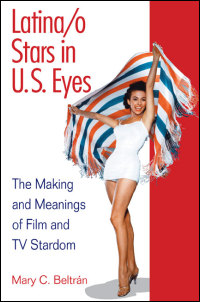 My research and the writing of my new book, Latina/o Stars in U.S. Eyes: The Making and Meanings of Film and TV Stardom, was such a lengthy process, during which the U.S. witnessed the blossoming of several Latino actors and actresses and TV series such as The George Lopez Show and Ugly Betty, that I had come to think that it as more a historical than a contemporary project. Even not-so-long-ago days when Jennifer Lopez was promoted as unique and newsworthy because of the shape of her derriere rather than her talent as an actor and when Latina and Latino performers, even those born in the U.S., might be described by entertainment journalists as “crossover” stars were behind us, I wanted to think.
My research and the writing of my new book, Latina/o Stars in U.S. Eyes: The Making and Meanings of Film and TV Stardom, was such a lengthy process, during which the U.S. witnessed the blossoming of several Latino actors and actresses and TV series such as The George Lopez Show and Ugly Betty, that I had come to think that it as more a historical than a contemporary project. Even not-so-long-ago days when Jennifer Lopez was promoted as unique and newsworthy because of the shape of her derriere rather than her talent as an actor and when Latina and Latino performers, even those born in the U.S., might be described by entertainment journalists as “crossover” stars were behind us, I wanted to think.
Then I witnessed the confirmation hearings last week for Judge Sonia Sotomayor after she was nominated for the U.S. Supreme Court. As Republican senators grilled the Puerto Rican, New York-born judge in particular on her comment during a speech that she had particular insight as a “wise Latina” judge, I became convinced that a study of the treatment of Latinos in the media has just as much relevance today as it did decades ago.
Comments made by senators and pundits during the political circus of the hearings underscored the fact that Latinos still hold an uncertain status with respect to national racial politics, that they are still not viewed by everyone as central to such discussions, and that confusion abounds regarding the racial and citizenship status of Puerto Ricans and other Latino groups. Rita Moreno encountered many of the same misconceptions when she began her career as a film actress at MGM. That was 50 years ago, however.
While the career paths and promotion of actors wishing to be considered potential stars in the entertainment media are of course of a different ilk than the career and public image of a Supreme Court nominee, there are important parallels. The widely diverging careers of Dolores Del Rio, Desi Arnaz, Rita Moreno, Freddie Prinze, Edward James Olmos, Jennifer Lopez, and Jessica Alba— the actors who serve as case studies in my book—demonstrate how being viewed as white or non-white, as citizen or foreigner, as wealthy or as working class, and as politically radical or middle-of-the-road dramatically affected and still affects Latina/o performers’ opportunities and how they have been marketed to audiences, as well as how and whether publicists promote them through capitalizing on stereotypical tropes. The intense scrutiny Judge Sotomayor has faced is not so different, it would seem.
*****
Mary Beltrán is an associate professor of communication arts and Latina/o studies at the University of Wisconsin-Madison. She is the author of the new book Latina/o Stars in U.S. Eyes: The Making and Meanings of Film and TV Stardom.
